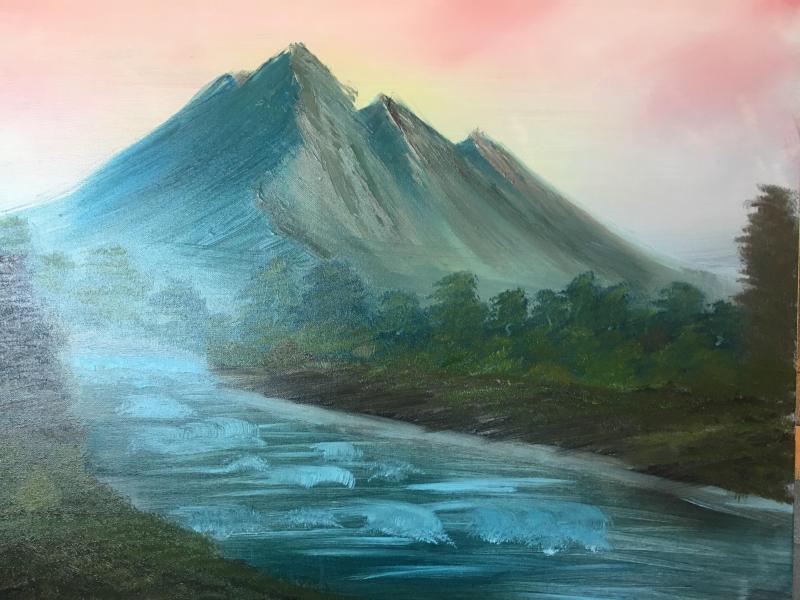Home › Forums › Explore Media › Oil Painting › Learning experience
- This topic has 5 replies, 4 voices, and was last updated 5 years, 9 months ago by
 virgil carter.
virgil carter.
-
AuthorPosts
-
July 3, 2018 at 1:29 pm #458430
Hello,
I havent been on for awhile, I have been trying to improve my painting. I was painting the today, when I learned a lesson about oil painting that astounded me. I wanted to share it with you all.
First you need to know two things, first, I use Bob Ross wet on wet technique, and second, I have been having problems with mud mixing lately. When I say mud mixing, I mean mixing colors so much on the canvas it turns brown or black. I have been having this problem lately. My paintings did not turn out that good for awhile.
Before painting today, I learned what my problem was. I had been putting too much liquid white on the canvas before starting, and I was pressing too hard with the brush on the canvas as opposed to a light touch.
Today, I tried to fix my problem. I put on the liquid white on the canvas, and then went over the whole canvas with a paper towel, removing all the excess paint and leaving a VERY thin layer of liquid white. I also tried using less pressure when using brushes on the canvas. It worked, and this is the result.

The white area on the side is the suns reflection. Its not paint.
This painting is not bad, in my opinion. However, if I learn from my mistakes, (or “happy accidents,) I am fine, regardless of the paintings outcome. There ARE areas I need to improve on, I know that, and as long as I keep trying and learning, I will get better.
What do you think of my experience?
On a side note, I am taking my paints and easel to a big 4th of July celebration today. I need something to do while waiting for fireworks.
Happy painting,
Jared
July 3, 2018 at 2:12 pm #652557Congratulations! You have discovered part of the secret of the Bob Ross method. The liquid white is what is sometimes known as a “couch”, providing a lubricant for the thicker paint to slide into and through, the white pigment mixes with the darker paints and creates subtle transitions. I prefer a couch without the white personally, as I like to mix my white into my paint directly to adjust the color as needed and sometimes because I just like to “block in” my painting with a single color in transparent gradations.
I think the lessons you learned are very good, brush pressure and control, surface structure making a difference. The absorbency of a surface can be used to incredible effect as well, so sometimes it’s good to have a dry surface to work on, like in the mid and foreground elements where you might want things to be more detailed and less implied with the brush shapes.
The biggest thing I learned from painting using the Bob Ross method was that it was just a beginning. Later I would come to realize that I did not have to finish a painting all in one session, I could come back after the paint was dry, put fresh paint on in various ways and achieve even better results.
- Delo DelofashtJuly 3, 2018 at 5:59 pm #652558I like this……good job!
Website: www.artderek.com
DEMONSTRATIONS:https://www.wetcanvas.com/forums/showthread.php?t=1363787
https://www.wetcanvas.com/forums/showthread.php?t=1343600
https://www.wetcanvas.com/forums/showthread.php?t=1431363July 3, 2018 at 6:23 pm #652559Hello,
Thank you all for your kind words. I really appreciate it.
I realized I forgot to sign it, I just did about five minutes ago.
Jared
July 3, 2018 at 7:23 pm #652556I wish I could be by your side as you encounter these experiences. There is a lot to be said regarding learning the exact amounts of mediums, to apply as a couch, and the “light” or “heavy” touch when applying paint with either a knife, or a brush is extremely important. I believe that you are beginning to learn those “feels” as you encounter those operations that you’re performing on your paintings.
These “feeling experiences” can be learned by one’s self, and by making mistakes, but the learning curve can be made much easier, and faster, by having someone with a bit of experience at your side, while you are doing it, explaining the “feels”, and results you should be expecting.

wfmartin. My Blog "Creative Realism"...
https://williamfmartin.blogspot.comJuly 3, 2018 at 7:47 pm #652560Hello,
@WFMartin, I see where you are coming from, and I believe you are right. I am starting to get a feel for it. For example, when I made the mountain. When I first started painting, I put a lot of pressure on the canvas with my pallete knife for the highlights. Eventually I learned what it SHOULD feel like, a light touch. As Bob Ross said, “No pressure.”
Believe it or not, you just gave me an idea for my next painting. I think I will try to make a video of how I paint, upload it, then put the link on a thread. That way, you can see how I paint, and in a way, be by my side, as you said.
I’ll probably do that tomorrow.
Thanks for the advice,
Jared
-
AuthorPosts
- You must be logged in to reply to this topic.
Register For This Site
A password will be e-mailed to you.
Search